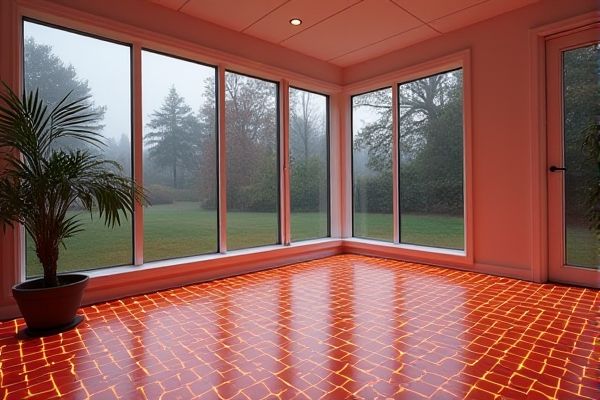
Heated floors provide consistent, energy-efficient warmth by evenly distributing heat across the sunroom surface, while radiant panels offer quicker, targeted heating with easier installation and control flexibility. Discover which heating solution best suits your sunroom and enhances Your comfort by reading the rest of the article.
Table of Comparison
| Feature | Heated Floor | Radiant Panel Sunroom |
|---|---|---|
| Heating Type | Embedded floor heating system | Mounted radiant panels on walls or ceiling |
| Installation | Requires floor renovation or new construction | Simple panel mounting, less invasive |
| Heat Distribution | Consistent, even floor-to-ceiling warmth | Direct radiant heat, focused on panel area |
| Energy Efficiency | High efficiency with thermal mass retention | Efficient but may lose heat through walls/windows |
| Comfort | Warm floors enhance comfort for bare feet | Quick heat, warms air and objects |
| Cost | Higher initial installation cost | Lower upfront cost, easier to install |
| Maintenance | Minimal once installed, hidden system | Requires panel cleaning and occasional checks |
| Best Use | Ideal for whole-room, long-term heating | Ideal for supplemental heating in sunrooms |
Introduction: Comparing Heated Floors and Radiant Panels for Sunrooms
Heated floors and radiant panels offer efficient solutions for maintaining warmth in sunrooms, enhancing comfort during colder months. Heated floors provide uniform heat distribution by warming the floor surface, creating a cozy atmosphere underfoot. Radiant panels, mounted on walls or ceilings, deliver targeted heat quickly, making them ideal for customizable temperature control in your sunroom.
How Heated Floors Work in Sunrooms
Heated floors in sunrooms operate through embedded electric coils or hydronic tubing beneath the flooring surface, providing consistent and energy-efficient warmth by radiating heat upward. This method ensures even temperature distribution, preventing cold spots and enhancing comfort during colder months. The thermal mass of the flooring material aids in retaining heat, making heated floors an effective solution for maintaining a cozy sunroom environment.
Understanding Radiant Panel Systems
Radiant panel systems use electric or hydronic panels installed in ceilings or walls to provide efficient, even heat distribution in sunrooms. These panels operate by emitting infrared radiation, warming objects and occupants directly rather than heating air, which enhances comfort and energy savings. Understanding how your radiant panels function can help optimize your sunroom's climate control compared to traditional heated floor systems.
Installation Process: Floors vs Panels
Heated floor installation typically involves embedding electric wires or hydronic tubing beneath the flooring material, requiring careful subfloor preparation and sometimes elevating floor height, which can extend project duration and costs. Radiant panel installation in a sunroom is generally surface-mounted or recessed into walls or ceilings, allowing for quicker setup with minimal disruption to existing structures. Your choice hinges on balancing installation complexity, timeline, and the architectural constraints of your sunroom.
Energy Efficiency: Which Option Saves More?
Heated floors deliver superior energy efficiency by distributing heat evenly through thermal mass, reducing heat loss and maintaining consistent warmth. Radiant panels quickly raise temperatures but often consume more energy due to rapid cycling and less heat retention. Your best choice depends on balancing upfront costs with long-term energy savings in the sunroom environment.
Comfort and Heat Distribution
Heated floors provide even warmth throughout the sunroom by radiating heat from below, ensuring consistent comfort underfoot and eliminating cold spots. Radiant panels offer targeted heat that warms surfaces and occupants quickly, making them ideal for supplemental heating but may result in less uniform temperature distribution. Choosing the right system for your sunroom depends on your preference for sustained, whole-room warmth or rapid, focused heat delivery.
Cost Comparison: Initial and Long-Term Expenses
Heated floors typically have higher initial installation costs due to the complexity of embedding heating elements beneath the flooring, but they offer energy-efficient, consistent warmth that can lower long-term utility bills. Radiant panels generally cost less upfront as they are simpler to install on walls or ceilings, yet may lead to higher operational expenses if the space is large or poorly insulated. Evaluating insulation quality and energy rates is crucial for determining the most cost-effective solution for a sunroom heating system over time.
Aesthetics and Space Considerations
Heated floors offer a sleek, invisible heating solution that maximizes space by eliminating wall-mounted units, allowing for uninterrupted design and furniture placement in sunrooms. Radiant panels, although more visible, provide flexibility with easier installation on walls or ceilings, which can complement architectural features without occupying floor area. Selecting between the two depends on balancing seamless aesthetics with spatial efficiency tailored to the sunroom's layout and design preferences.
Maintenance and Durability
Heated floors typically require minimal maintenance and offer long-lasting durability due to their installation beneath the surface, protecting them from wear and tear. Radiant panels in a sunroom may need more frequent checks for dust accumulation and electrical components to ensure efficient operation. Your choice should consider the ease of upkeep and the resilience of each system based on your sunroom's usage and environmental conditions.
Which Heating Solution Is Best for Your Sunroom?
Heated floors provide consistent, energy-efficient warmth by evenly distributing heat beneath the surface, making them ideal for sunrooms with tile or stone flooring. Radiant panels offer quicker, targeted heat and work well with various floor types, especially in sunrooms where rapid temperature control is needed. Choose the solution that matches your sunroom's flooring material and desired heating speed to optimize comfort and efficiency for your space.
 homyna.com
homyna.com